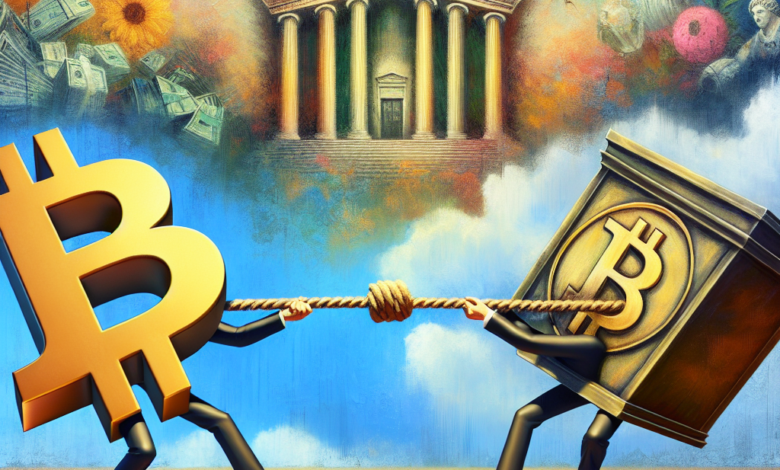Bitcoin vs. Traditional Banking: The Battle for Financial Freedom

In the evolving landscape of finance, Bitcoin has emerged as a formidable challenger to traditional banking systems. As we venture deeper into the 21st century, the clash between these two financial paradigms is shaping how individuals perceive money, savings, and financial interaction. This article delves into the core differences between Bitcoin and traditional banking, the advantages and challenges of each, and the implications for financial freedom.
Understanding Bitcoin and Traditional Banking
Bitcoin: A Decentralized Currency
Bitcoin is a decentralized digital currency that allows peer-to-peer transactions without the need for intermediaries like banks. It operates on blockchain technology, which ensures transparent and secure transactions. Founded in 2009 by an anonymous entity known as Satoshi Nakamoto, Bitcoin was designed to be a new form of currency free from the control of governments and financial institutions.
Traditional Banking: A Centralized System
Traditional banking, on the other hand, is built on a centralized structure where financial institutions manage currency and facilitate transactions. Banks offer a range of services including savings accounts, loans, and investment products. They are regulated by government bodies, which provide a safety net for depositors but also subject the banks to various controls and restrictions.
The Appeal of Bitcoin
Financial Independence
One of the primary attractions of Bitcoin is its promise of financial independence. With Bitcoin, users have complete control over their funds. They can transact directly without intermediaries imposing fees or restrictions. This is particularly empowering in regions where traditional banking infrastructure is lacking or where individuals want to avoid exorbitant banking fees.
Transparency and Security
The blockchain ledger is immutable, meaning that once a transaction is recorded, it cannot be altered. This transparency fosters a sense of security for users. Transactions are pseudonymous, providing privacy without the need for sensitive personal information to be shared.
Inflation Resistance
Bitcoin has a capped supply of 21 million coins, which contrasts sharply with fiat currencies that can be printed at will by central banks. This makes Bitcoin an attractive hedge against inflation for many investors.
The Limitations of Bitcoin
Volatility
While Bitcoin offers potential for high returns, it is notorious for its price volatility. Sudden fluctuations can lead to significant financial losses, making it a risky investment compared to the stability of traditional currencies.
Regulatory Uncertainty
Bitcoin exists in a gray area concerning regulations. Governments around the world are grappling with how to approach cryptocurrencies, leading to uncertainty that can impact its adoption and value.
Adoption Barriers
Despite growing popularity, Bitcoin’s usability in everyday transactions remains limited. While more merchants are beginning to accept it, widespread acceptance is still a hurdle.
The Strengths of Traditional Banking
Stability and Reliability
Traditional banks provide consumers with a sense of stability and trust cultivated through decades of operation. Funds deposited in banks are typically insured by government agencies, providing a safety net for depositors.
Comprehensive Services
Banks offer a broad array of services that encompass checking and savings accounts, loans, mortgages, and investment options. This one-stop-shop model caters to diverse financial needs seamlessly.
Regulatory Oversight
Regulations imposed on banks are designed to protect consumers and ensure the system’s integrity. This oversight helps foster confidence and stability within financial markets.
The Drawbacks of Traditional Banking
Fees and Charges
Traditional banking services often come with a host of charges, from maintenance fees to transaction fees. These costs can quickly add up, disproportionately affecting low-income individuals.
Limited Access
In many parts of the world, access to banking services is limited. Individuals in rural or underserved areas may find it challenging to access essential banking services, reinforcing financial exclusion.
Centralized Control
Traditional banking is vulnerable to central authority decisions, and consumers have little control over their own funds. Economic downturns or poor management can lead to crises that impact millions.
The Path Forward: A Hybrid Future?
As technology and consumer preferences evolve, the future of finance may not be a strict battle between Bitcoin and traditional banking but rather a convergence of the two. Some banks are now adopting blockchain technology to enhance their services, and digital currencies issued by central banks (CBDCs) are gaining traction.
Conclusion
The clash between Bitcoin and traditional banking underscores a larger debate about financial freedom and control. While Bitcoin offers a radical departure from conventional finance, traditional banking remains a cornerstone of economic systems worldwide. As individuals navigate their options, the ultimate choice may hinge on personal values, needs, and the unique circumstances defining their financial journey. The evolution of this dynamic will undoubtedly influence the future of finance, potentially empowering individuals like never before.
